|
Archive of Past Artist - for reference only At the close of the 2017 Season, Both North Rim and South Rim AiR Programs will be been suspended indefinitely. You may check this webpage periodically for updated information. If you have further questions, you may email us at GRCA_AiR@nps.gov 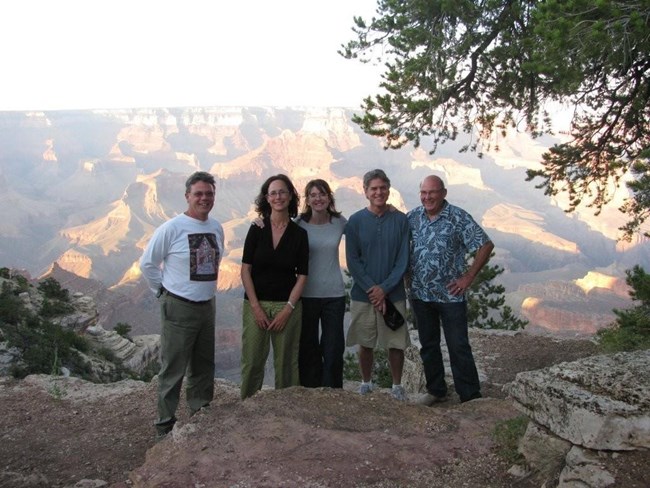
photo by Rene Westbrook Meet the Jurors!
The new South Rim year-round artist-in-residence program was honored to seat this talented panel of specialists this season. The panel (left to right): Bert Harclerode: Sedona, AZ. Executive Director of Chamber Music Sedona, Bert also plays the tuba for Flagstaff Symphony. Trisha Watts: Occidental, CA. Founder and Director of EcoArtSpace, a west-coast environmental arts program. Kim Buchheit: Grand Canyon, AZ. Kim is a free-lance graphic designer, a mixed-media visual artist and founder of Buchheit Creative Services. Richard Chalfant: West Chester, PA/Hana-Maui, Hawaii. Rich was a South Rim AiR in the winter of 2008 and served as an artist-consultant to the new year-round program for two months during the 2009 summer. Tom Pittenger: Grand Canyon, AZ. Tom is the editor/writer for the National Park Service at Grand Canyon National Park. Tom has served on both the South and North Rim AiR jury panels since the inception of the program in 2003.
Grand Canyon National Park is pleased to annouce the October 2009 - September 2010 South Rim artist-in-residence participants!
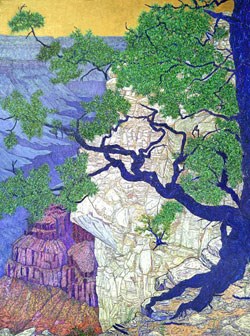
acrylic and mixed media on canvas Imminent Depth Painter Susan Klein is the October 2009 artist-in-residence. Born in Dayton Ohio, and now living in Sarasota, Florida, Susan has been painting and exhibiting for over thirty years, consistently winning awards and recognition, and exhibiting widely. She has her undergraduate degree in studio arts from Youngstown University, Youngstown, Ohio, and a MFA degree (painting emphasis) from Kent Sate University and has taught, run her own gallery and participated in National Park Service artist-in-residence programs at Everglades, Yosemite, the north rim of Grand Canyon, Acadia, and now at the south rim of Grand Canyon. Susan: “Travel to different landscapes excites my senses and imagination and re-ignites my creative spirit. My work is highly detailed and time consuming. For me the composition of the painting and its meaning are there in the landscape. I isolate and make the composition clearly visible with a sketch. I then work from the shorthand of that drawing in the studio; the sketch conveys the necessary creative memories through the energy of the drawn line – memories of how the place and that particular configuration of trees and sky, water and grass, along with breezes and fragrances, made me feel – and there I find my content. My paintings are my life’s contribution to posterity, presenting another forceful, visible voice for preservation and conservation of our natural heritage.” While in-residence, Susan will do a Plein Air demonstration on the Rim Trail and an Evening Program about her own work and past experiences as in other National Parks as an artist-in-residence. Her own work will continue her painterly explorations of the landscape, both Plein Air and in-studio. 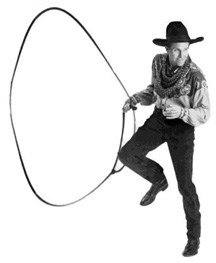
Cowboy Randy Erwin in action Singer/yodeler “Cowboy” Randy Erwin is the November 2009 artist-in-residence. Randy grew up on a family rice farm in south Texas, where he learned to pass his time while working the plow by singing “continuously, loudly and badly for 12 hours a day”. After years of studying classical piano, Randy picked up a trumpet and joined a local polka band, which later morphed into a “bad” country western cover band. Randy has his undergraduate degree in film and radio production from the University of Texas, Austin, and will begin graduate studies in communications and fancy girlish ballroom dancing at the University of Illinois at Springfield, January of 2010. He is also a self-taught trick roper and delights children of all ages with his entertaining skills during his musical performances. Randy currently lives in Springfield Illinois, working in the schools as a performing artist, and as a living history actor (playing The Ghost) at the Abraham Lincoln Presidential Library. A short sample of Randy’s performing history includes the New Orleans Jazz Festival, the Seattle International Children’s Festival, Library of Congress, Canadian and National Public Radio, Carnegie Hall, as a singer/yodeler for the Disney movie “Home on the Range” and playing a cowboy yodeler/trick roper in the indie movie “True Stories”. Randy: “I’m currently creating multi-track, wordless, a Capella songs using extended vocal technique (including yodeling). These tracks will then be engineered to interact with the natural acoustics of any given space, and intertwined with ambient noises including the sound of water, rock-fall, fauna, wildlife, or people. All tracks will be mixed and mastered in coordination with video and still pictures into work that will be presented in live performance.” While in-residence, Randy will perform at an assembly for our local public school and present an Evening Program performance of original music, traditional cowboy tunes and do some trick roping. Randy will spend his own time collecting ambient sounds of the Canyon for future projects. 
Pinhole Photograph Mary Colter's Watchtower Pinhole photographer and sculptor Kim Henkel is the December 2009 artist-in-residence. Originally from Pennsylvania, Kim holds a BA in arts education and received a MFA from Arizona State University (sculpture emphasis). For the past three years, Kim was the artist-in-residence program coordinator and a seasonal Interpretation Ranger at Mt. Rushmore National Monument. She’s taught as adjunct faculty at Northern Arizona University, South Dakota School of Mines & Technology and Western New Mexico University, and has participated in many artist-in-residence programs including Petrified Forest National Monument and Anderson Ranch Arts Center. Kim frequently exhibits her work in solo and group exhibitions of both her pinhole photographs and her mixed-media cast sculptures. Kim: “My focus is preserving that “moment of discovery” in my pinhole photographs, which is based on my concepts of preservation and conservation. The pinhole photographs are capturing an image of that specific moment, but with the pinhole you get an image that aesthetically seems historical. The pinhole is a completely primitive way of taking photographs, dating from the early 1800s and my cameras are all hand-made out of recycled materials. The final images are in total depth of field and in black and white. In this world of technology and computers, I feel that artists have stepped away from the wonderful process of darkroom work and hands-on personal experiences in photography. I’m working on a long-term Southwest portfolio project which will eventually become a book that documents National Parks and special places that need and deserve our conservation efforts.” While in-residence, Kim will teach a four-day workshop in pinhole photography in our local public school and present an Evening Program about her on-going Southwest portfolio project. She will be working on a continuation of her ambitious on-going Southwest pinhole photography portfolio project. 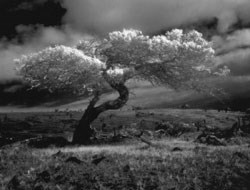
gelatin silver selenium-toned photographic print Mauna Kea Tree Study #1 Landscape photographer Michael Miner is the January 2010 artist-in-residence. For the past 25 years, Michael has taught creative writing and worked as a screenwriter, cinematographer and director in Hollywood and around the world. Michael received his undergraduate degree from the University of California, Riverside, in English Literature and Theater, and his MFA from UCLA Film School with a degree in Motion Picture & Television Production. His cinematic credits include co-writing the screenplays for the movies Robocop, Robocop: The Television Show, Anacondas: Curse of the Blood Orchid, and Lawnmowerman 2; and he was the writer/director of Deadly Weapon, as well as director of The Book of Stars. Michael also exhibits his photographs extensively and published the photographic book One Thousand Words /The Landscape Images of Michael Miner (February 2008, A & I Press). Michael: “As a screenwriter, cinematographer and director, I have aimed for purity of self-expression and clarity of vision. I strive to apply the same rigor and discipline in taking a landscape photograph that I do in making a film. Time spent in a place is essential to making detailed explorations that will result in both vast and intimate images. It is the only way great photography can be achieved. In the process of teaching I have also discovered that real knowledge cannot be bought, sold or acquired through an act of will. It is a gift passed on from generation to generation. This also applies to art, which is a gift, and is essential to maintaining in the public’s mind the concept of “sacred spaces” which can and must sustain us in perpetuity.” While in-residence, Michael will do a rim demonstration on the methods and techniques of large-format landscape photography, and present two Evening Programs on his work and the history and principals of photography. He will be adding to his extensive collection of images of the landscape and archeological sites while here at the South Rim. 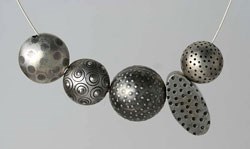
Silver Assorted silver beads
Contemporary jeweler and metal smith Erica Stankwytch Bailey is the February 2010 artist-in-residence. Erica holds a BA in Women’s Studies and a BFA in Metal Design from East Carolina University in Greenville. She has taught in public schools, at the Community College level and at art centers, regionally, and is the winner of several exhibit and artist merit awards. Erica shows and sells her work nationally at festivals, art centers, galleries and museums. Her work has also been featured in solo and group shows. This will be Erica’s first visit to the Grand Canyon. Erica: “My work has always been inspired by the textures of the earth. The pages of my sketchbook are full of drawings, photographs and renderings of organic/natural elements which I then translate into metal objects. I have always been intrigued by the miniscule within the larger body; a beautiful shell in the sea, a cell within the stem of a plant, jewelry on the wearer, a rock or leaf in the vast wilderness. The relationship of small within large or species within habitat must be truly dynamic in the vastness of the Grand Canyon. The amazing/beautiful/wonderful thing about the environment is that the enormous depends on the small. I want to experience that Canyon and its amazing biodiversity, myself representing the small being within the larger environment” While in-residence, Erica will serve as the guest juror for the Seventh Annual Student Art Exhibit at Kolb Studio here at the South Rim, and will present an Evening Program about her work and metal smithing methods. In-studio, Erica will be working with the most basic of tools while here at the South Rim, simplifying process and focusing on the act of spontaneous creation. 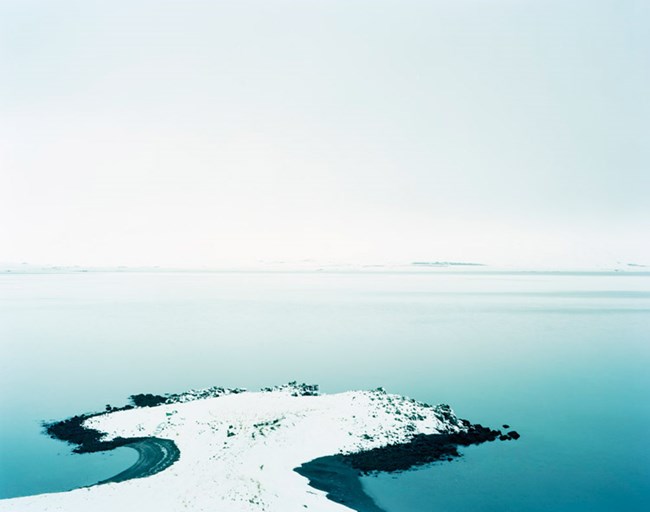
C-Print Devon Island Coast Contemporary photographer Bridget Batch and videographer Kevin Cooley are the March 2010 collaborative artists-in-residence. Bridget has her BFA in photography from the University of Houston, Texas. Her residency experiences include FABRICA in Terviso, Italy in 2001; Salem Art Works in Salem, New York in 2007; Salem Herhúsið, Siglufjörður, Iceland in 2008 and she and Kevin will be co-artists-in-residence at the Klondike Institute of Arts & Culture, in Dawson City, Canada in 2010. Bridget has participated in many solo and group exhibitions, both in the United States and internationally. Kevin has a BA in International Affairs from Lewis and Clark College in Portland, Oregon and holds a MFA in photography from The School of Visual Arts in New York. Kevin shared a collaborative residency with Bridget at Salem Herhúsið, Siglufjörður, Iceland in 2008; they will also collaborate in 2010 at the Klondike Institute of Arts & Culture. He’s won many awards for his art, including purchase awards and fellowships, and is in the collection at the Solomon r. Guggenheim Museum in New York. Bridget and Kevin: “We, like so many others, are drawn to the Grand Canyon in order to experience the sensations of awe and wonder compelled when standing at the edge and staring into the abyss. In its greatness, the Grand Canon forces us to recognize perspective and scale. It also reminds us that in spite of our efforts to conquer and govern Nature, and despite the damage we as humans cause to nature, there are forces far beyond our control. Nature and the Universe are ultimately at the helm and we are merely passengers. This struggle between (hu)Man and Nature is an ongoing theme in our work and the South Rim is a perfect location for continuing to explore this battle. In the Grand Canyon there are so many possibilities for encountering nature at its most sublime, and will provide fantastic visual opportunities for our work.” 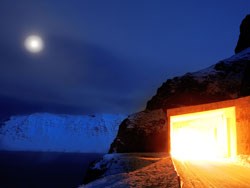
C-Print tunnel and Moon While in-residence, Bridget and Kevin will be working in the local school on a three-part video project that will also include contact with park visitors. This work will culminate in a public presentation of the on-going work and process. Meanwhile, on their own projects, Bridget will be researching and interviewing local tribal members about cultural beliefs of the Native Americans living in the Canyon region, as part of an ongoing project. Kevin will be pursuing photographic documentation of daily visitor activity from a specific point as well as night photography. They will also work on a collaborative project in a series of short videos involving willing park visitors experiencing the Canyon. 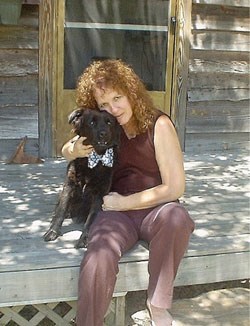
Me and Max Writer Dana Wildsmith is the April 2010 artist-in-residence. Dana holds her BA in Sociology from Virginia Wesleyan College in Virginia Beach. She currently is an English literacy instructor at Lanier Technical College in Gainesville, Georgia and is an instructor/trainer at the National Center for Adult English Language Acquisition in Washington D.C. Dana has been a freelance teacher and guest speaker for a wide variety of prestigious programs, including The Appalachian Writers’ Conference, Duke University Writers Workshop, and Tennessee Writers’ Conference. She also participated as an artist-in-residence at The Island Institute in Sitka, Alaska; Devil’s Tower National Monument in South Dakota and at the Atlantic Center for the Arts, to name just a few. Dana was the poetry fellow for the South Carolina Academy of Authors in 1996 and has won many awards for her writing and has been widely published. Her newest book, Back to Abnormal: A Memoir of Survival with an Old Farm in the New South (Motes Books) will be available this spring. Dana: “When I visited the Grand Canyon for the first time in May of 2009, I kept finding myself watching the other visitors and was struck by how at-home most of them appeared to feel. I’ve spent a lot of time in public lands and have never seen anywhere else such a sense of belonging as I saw all along the South Rim. Americans in particular seem to think of the Grand Canyon as their park, perhaps even as the park which most exemplifies American wilderness. Because I just completed writing an environmental memoir focusing on who we and how we, in a swiftly urbanizing world, think about nature – or even if we think about the natural world, I am focused on this modern culture/wilderness connection and the probably somewhat unconscious affinity that park visitors feel towards the Canyon.” While in-residence, Dana will work with the middle school students at our public school, conduct a writing workshop in the inner-Canyon, and do a formal reading as an Evening Program. In-studio, Dana will focus on her own current writing project. 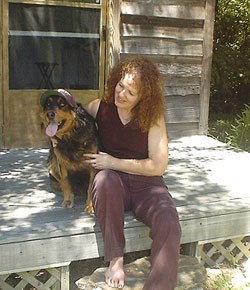
Me and Fred Our border collie Max, I say, would be a bow-tie guy, a grey slacks with cuffs kind of guy, his solid-color long-sleeved shirts always lightly starched. For casual, he’d keep pressed khakis on wooden hangers and white golf shirts with left-sleeve monogram.
Fred the red hound would live in faded 501’s and Carhartts, Dixie Outfitter shirts, and ball caps promo-ing beer and football and backhoes.
We’re sure Max is a Whiskey-Palian, 20-year deacon, high church, early Mass. Fred’s kin have been Baptists, by God, since time began on Sunday, October 23rd, 4004 B.C.
Sundays after church, Fred eats Mama’s fried chicken and watches the game. Max does the buffet at the Club, drives his white Volvo home and now politely corrects us, “You have me all wrong, you know.” But he won’t say how.
Fred’s F-150’s spinning gravel out front and he yells he’ll catch us later-- gotta get that squirrel before it makes it to a tree.
So we sit on the porch with Molly, the damaged black Lab. She was a preacher’s kid, never heard a cuss word till high school, believed in the goodness of man until one man beat that guilelessness out of her. Now Molly slips around the edges of her days not looking at the world so the world won’t exist.
But even Molly’s pleased when Barney, the old beagle, comes bowlegging over to find out what’s new with us. He’s got time to palaver, now he’s retired from the mill. He hitches his overalls at the knees and eases to a rocker, informing us that whoo, lordy—it’s going to be a hot one today.
Later this evening he’ll have his coffee at Waffle House with Roscoe and Willie, and he’ll tell the other dogs how he talked to me earlier and don’t they think I’d be an Irish Setter? Not a prissy bred-for-show, mind you, but one of those country Setters, always up for a walk…. 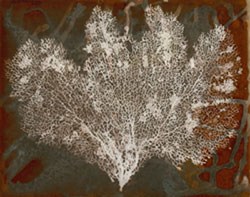
Photogram on manipulated printing-out paper #1 from the Specimen Series Photographer and mixed media artist Leah Sobsey is the May artist-in-residence. Leah has a BA in Anthropology and Studio Art from Guilford Collect in Greensboro, North Carolina and a MFA from San Francisco Art institute with an emphasis in metal smithing. She is widely exhibited in solo and group shows nationally and has won numerous awards for her work. Leah had a teaching residency at HABLA, The Center for Language and Arts in Merida, Mexico in 2008, and was an artist-in-residence at Vermont Studio Center in 2006 and Anderson Ranch Art Center in 2000, to name a few. Her work is in the collection of Bill Gates Microsoft Collection as well as San Francisco Art Institute. She also has been published in numerous art magazines as well as literary/arts publications. Currently Leah is a guest lecturer at the University of North Carolina in Greensboro. Leah: “Part of a residency is to just be, so ideas percolate while the landscape motivates and inspires. I work with cyanotype, which is one of the oldest photograph processes, invented in 1842 by Sir John Hershel. It is a contact printing process using ultraviolet light to create an image on coated photographic paper or cloth. This process is dependent on the landscape and natural habitat by utilizing the sun to create the impression of the image as well as the source materials. The Grand Canyon is the perfect fit for my process and interests.” While in-residence, Leah will be conducting a series of workshops for the students at Grand Canyon school and park visitors. In-studio, Leah will be working with the local flora, continuing her current series of mixed-media cyanotypes. 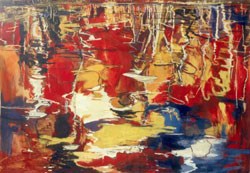
acrylic on canvas from the Water Paintings series Painter David Alexander is the artist-in-residence during the month of June. David comes from Lake Country, British Columbia. David grew up in Vancouver, British Columbia and has his BFA from Notre Dame University in British Columbia, and his MFA from the University of Saskatchewan with an emphasis in painting. He has extensive and lengthy exhibit experience, widely showing his work in Canada, the United States, and Europe, with recent solo and group exhibitions in Seattle, Toronto, the Chicago Art Fair, Banff, Alberta, London, and many others too numerous to mention. David collects his visual information while on research expeditions to such remote locations as Argentina, the high deserts of Utah and Nevada, Iceland, Greenland, Baffin Island, and the Canadian high arctic. His travels inspire his landscape paintings focusing on massive geological processes. David: “My early natural influences came mostly from my father’s occupation as a tug- and charter boat captain. During the summers, we traveled up and down the West Coast with him, both for pleasure and work. Moving slowly through the landscape by tugboat, pulling loads that went from Vancouver to Alaska in the early 1960s, we visited very pristine places, unpopulated and totally wild. My mother was a watercolorist and loved to view art in galleries and had me interested in art at a very early age. Being in the landscape will always be the major art-making catalyst for me. In my first and only visit to the Grand Canyon (three years ago), I was so overwhelmed by the size and geological complexity that I was unable to even start to make art. This visit was a shock, as I am used to mountainous regions that I climb and hike from the bottom up, and not from the top down. The ‘in’ for me was when I saw the river, and my mind started to tell me stories of erosion, geology, and human experience within the canyon walls. I have a feeling that this living water at the bottom will be the start of my story there.” While in residence, David will present three evening program talks focusing on his artwork and the influence his travels have had on his body of work. For his studio work, David will be hiking and collecting visual information in search of a better understanding of the canyon culture and the geological processes that carved this immense landscape. 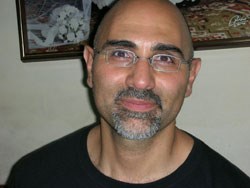
Combining audio, image and text, new media artist Andrew Demirjian is the July artist-in-residence. Andrew received his MFA in Integrated Media Arts from Hunter College, New York, New York, and currently is a professor at Monmouth University in New Jersey teaching courses in video production, visual culture, and film history. His work has been featured in exhibitions, including the Center for Book Arts, New York, NY; LMAK Projects, Brooklyn, New York, and Harvestworks, New York, NY. Over the last year he has had multiple international exhibitions including the Garden of Earthly Delights in Korea, Küf/Mold in the Netherlands and Analogue/Digital in England. Andrew received a 2006 fellowship from the New Jersey State Council on the Arts, a Puffin Foundation grant, and an Artslink grant. He has served artist in residencies at the Bemis Center for Contemporary Art, the Newark Museum, the Experimental Television Center, the CYLAND Media Laboratory, and the Visual Studies Workshop. Andrew: “I’m a media artist who focuses on creating alternative relationships between audio, video, and text that take the form of single-channel videos and multi-channel installations. The work is often influenced by traditional painting genres (landscape, portraiture, still life, etc.), but reinterpreted through computational processing. The pieces twist conceptions of spatial barriers and interiors/exteriors, remapping data to alter customary perceptions of space. The Grand Canyon is one of the most photographed landmarks in the United States, but what is the aural landscape like in this visually compelling terrain? What are the sonic effects of the sculpted rock patterns and what effect do extreme elevation shifts have on the sonic environment? My Audio Landscapes intends to address these questions and visualize and concretize the ethereal world of shifting sonic flows.” While in residence, Andrew will present two audio walking tours on the rim and do one evening program presentation about his past work and the on-going work that this residency is inspiring. His own work will focus on collecting audio and visual files, continuing his interest in merging the technological and the organic as related to human perception.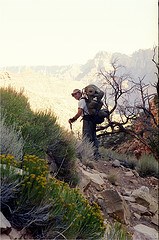
Writer Rick Kempa is the August artist-in-residence. Born in Chicago, Rick has lived in Rock Springs, Wyoming for the past 22 years. Rick received his BA in Philosophy from St. John’s College in Santa Fe, New Mexico, and his MFA in creative writing from the University of Arizona in Tucson. He has presented his poems and prose at numerous public readings at several venues in Wyoming, Utah and Colorado. Rick has won fellowships and awards for his writing, including a Wyoming Arts Council’s Literary Fellowship. Rick has a collection of poetry, Keeping the Quiet (Bellowing Ark Press, 2008) and has been widely published in journals and anthologies. He teaches writing and philosophy and directs the Honors Program at Western Wyoming Community College in Rock Springs. Rick: “For several years I have been working on a collection of essays based on my 36-year history of hiking in Grand Canyon, weaving strands that include appreciation of the natural wonders of the Inner Canyon, reflections about others who have wandered the region on foot, narratives of certain memorable hikes, philosophical musings, and celebrations of the unique rhythms and perspectives of the backpacking way of life. I am especially interested in the spectrum of relationships that people have had with the canyon; objectifying it as a place to “own” or “exploit” or “conquer”, raising barriers (like endless chatter or, on another level, dams) to keep it at bay, tentatively experiencing its silence, solitude and vastness, or, given enough time, wholly entering it. These essays are my attempt to capture, in the truest language I can find, some of the essence of the place where I am most at home.” While in residence, Rick will present two evening programs, reading from his ongoing collection of canyon essays, and will also do a special evening program at Phantom Ranch for fellow hikers. The remainder of Rick’s time will be given over to continued work on his Grand Canyon essays and poems.
Excerpt from “Coming Into Being: A Grand Canyon Hike”: No matter how often I've been here, it’s the same each time I come. I begin by learning how to walk again. I don't mean city-style walking, so bland, with everything cemented and nothing in the way, that it's impossible to forget. The walk out here is of another kind: It requires a unit of awareness that I've grown accustomed not to give. I drove all night to get here, yet I am painfully conscious of not having moved. Hurriedly, I lace my boots—too loose, but good enough—do a few quick stretches, and heft my pack. At 50 or so pounds, the first feel of it is shocking. The shoulder straps press through the cloth to the bone. My arms immediately grow numb, and I flap them, flex the fingers. But I am comforted by the thought that within my pack are all the provisions I will need for the next nine days, that I will eat my way out from under it, and that I'm going down, not up; gravity will assist me in my passage. The one other vehicle in the parking area is frozen-over, seemingly rooted. A couple of pairs of boot-prints swirl out in the snow from it, then converge at the edge of the trees in what I take to be the trail. Cold air needles my lungs, and the veins in my legs are twitching. I pat the hood of my truck farewell—the heat is startling, almost already nostalgic—and set out. 
Sound artist Aaron Ximm is the September artist-in-residence. Aaron was born in Chicago, but frequently moved during childhood, living in such diverse places as London, England; Evansville and Indianapolis, Indiana; rural Utah as well as Salt Lake City; Lahaina on Maui; and Milwaukee before returning to Chicago to attend Northwestern University. There he received his BA in cognitive science and English literature/creative writing. He has been an artist-in-residence at the Headlands Center for the Arts in Sausalito, California, and the Binaural Media’s Nodar Guest Studio in Nodar, Portugal. Aaron has been a guest lecturer at Edgetone Music Summit in Oakland, California, and the Third Coast International Audio Festival in Chicago, Illinois. He has created mixed-media installations, released CDs, and published written work on his art. Aaron currently lives in San Francisco and is known for his composition, installation, and performance work featured on his web site Quiet American. From 2001 to 2005, Aaron curated and hosted the Field Effects concert series, which, like his own work, sought to showcase the quiet, fragile, and lovely side of sound art, particularly that working with “found sound” and field recordings. Aaron: “I am a sound artist. I compose soundscapes and make site-specific installations using my own field recordings. One of my intentions as an artist is to help the quiet parts of the world to speak for themselves. In that role I am sometimes more of a curator or editor than a musician or composer. A few years ago I was fortunate enough to raft the lower half of the canyon with my family. Because our trip was in October, motor traffic had ceased on the river, and we experienced the majestic quiet of the canyon floor for many days. In the side canyons, away from the roar of the Colorado, the smallest detail of the many soundscapes I encountered loomed large. The sound that has haunted me since that trip is the murmur of a small creek running through narrow places. Between any rock walls, a resonant space is formed. In the canyons, the white noise of running water is filtered and shaped, taking on a more musical quality, almost as if a faint chord were being played. Such “canyon melodies” interest me because each is in one way a song both sung by, and about, the formational process of a canyon. Many visitors are of course reminded of such forces and processes visually, but I would like to help people to hear them as well.” While in residence, Aaron will conduct two on-site workshops; programs that entice park visitors and residents to walk “following their ears” and to become aware of natural quiet and ambient soundscapes. Aaron will also do an evening program which will introduce the audience to the world of soundscapes and site-specific mixed-media installations. While in residence, Aaron will continue his pursuit of collecting the “ephemeral fragile sounds on the quieter margins of the world”. Former Selected Artist in Residence (for reference): Selected Artists - South Rim - October 2014 - October 2015Selected Artists - South Rim - October 2013 - October 2014 Selected Artists - North Rim - 2013 Selected Artists - South Rim - 2012-2013 Selected Artists - South Rim - 2011 - 2012 Selected Artists - North Rim - 2011 Selected Artists - South Rim - 2010 - 2011 Selected Artists - North Rim 2010 Selected Artists - South Rim - 2009 - 2010 |
Last updated: September 28, 2016
